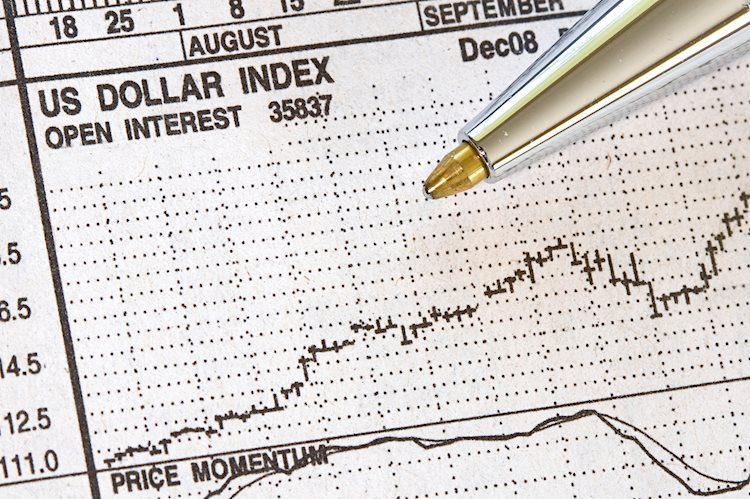
- DXY rallies further following Federal Reserve’s decision, trades above 105.00.
- US releases soft PPI figures from May and higher weekly Initial Jobless Claims.
- US Treasury yields continue to move down and may limit the upside.
On Thursday, the US Dollar Index (DXY) continued its positive momentum, extending its recovery into Thursday’s session above 105.00. This followed Wednesday’s Federal Reserve (Fed) decision and as markets digested fresh Producer Price Index (PPI) figures from May and weekly Initial Jobless Claims, which showcased weaker than anticipated inflation and higher unemployment benefit requests.
The Fed kept its economic activity revisions unchanged while upgrading the Personal Consumption Expenditures (PCE) forecasts. The US economy is currently showcasing mixed signs with preliminary evidence indicating softening inflation but with a resilient labor market, which seems to have made Fed officials project fewer rate cuts in 2024.
Daily digest market movers: DXY reacts to Fed decision, PPI data
- Federal Open Market Committee (FOMC) dot plot update on Wednesday shows just one rate cut for 2024 as the median outcome, down from the three rate cut expectation last March by Fed Officials.
- This adjusted the market’s expectations, which priced in between one or two cuts this year, indicating a longer timeline for potential rate cuts.
- Producer Price Index (PPI) for final demand rose 2.2% on a yearly basis in May, below the market expectation of 2.5%.
- Annual core PPI rose by 2.3%, also below market expectations.
- Weekly Jobless Claims showed 242K in the week ending June 8, higher than initial estimates of 225K and last week’s print of 229K.
DXY technical analysis: Bulls maintain control and recover SMAs
Following Wednesday’s session, indicators recovered to stand in positive terrain. The Relative Strength Index (RSI) is now above 50 midline, and the Moving Average Convergence Divergence (MACD) is printing green bars. In addition, the Index is now trending above its 20, 100, and 200-day Simple Moving Averages (SMA). This extends the bullish outlook for the US Dollar, following Wednesday’s sharp decline.
Fed FAQs
Monetary policy in the US is shaped by the Federal Reserve (Fed). The Fed has two mandates: to achieve price stability and foster full employment. Its primary tool to achieve these goals is by adjusting interest rates. When prices are rising too quickly and inflation is above the Fed’s 2% target, it raises interest rates, increasing borrowing costs throughout the economy. This results in a stronger US Dollar (USD) as it makes the US a more attractive place for international investors to park their money. When inflation falls below 2% or the Unemployment Rate is too high, the Fed may lower interest rates to encourage borrowing, which weighs on the Greenback.
The Federal Reserve (Fed) holds eight policy meetings a year, where the Federal Open Market Committee (FOMC) assesses economic conditions and makes monetary policy decisions. The FOMC is attended by twelve Fed officials – the seven members of the Board of Governors, the president of the Federal Reserve Bank of New York, and four of the remaining eleven regional Reserve Bank presidents, who serve one-year terms on a rotating basis.
In extreme situations, the Federal Reserve may resort to a policy named Quantitative Easing (QE). QE is the process by which the Fed substantially increases the flow of credit in a stuck financial system. It is a non-standard policy measure used during crises or when inflation is extremely low. It was the Fed’s weapon of choice during the Great Financial Crisis in 2008. It involves the Fed printing more Dollars and using them to buy high grade bonds from financial institutions. QE usually weakens the US Dollar.
Quantitative tightening (QT) is the reverse process of QE, whereby the Federal Reserve stops buying bonds from financial institutions and does not reinvest the principal from the bonds it holds maturing, to purchase new bonds. It is usually positive for the value of the US Dollar.
- SEO Powered Content & PR Distribution. Get Amplified Today.
- PlatoData.Network Vertical Generative Ai. Empower Yourself. Access Here.
- PlatoAiStream. Web3 Intelligence. Knowledge Amplified. Access Here.
- PlatoESG. Carbon, CleanTech, Energy, Environment, Solar, Waste Management. Access Here.
- PlatoHealth. Biotech and Clinical Trials Intelligence. Access Here.
- Source: https://www.fxstreet.com/news/us-dollar-extends-recovery-as-market-digests-fed-revisions-and-ppi-data-202406131559



